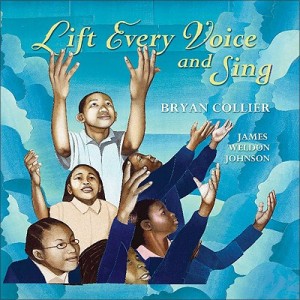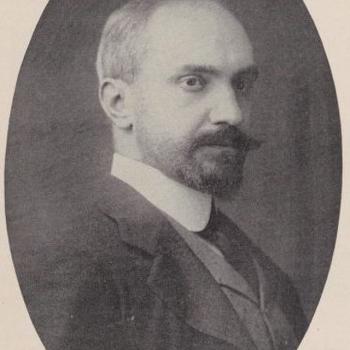This week, our kid’s favorite book-to-have-read-to-her is Lift Every Voice and Sing. Illustrated by Bryan Collier, the book creates a pictorial narrative for the words of the hymn written by James Weldon Johnson in 1900. It is not the lightest bedtime reading, for me—“We have come over a way that with tears has been watered, / We have come, treading our path through the blood of the slaughtered”—but our Little Bean is very clear when she hands me the book that this is the book she wants. And again, please. And again. She has been drawn to music since infancy and basically seems to revel in any book that gets us to sing to her, so that’s probably what the attraction is here. And so I sing it, with gusto, again and again, and again.
 “God of our weary years, God of our silent tears, / Thou who has brought us thus far on our way; / Thou who hast by Thy might, Led us into the light, Keep us forever in the path, we pray.” This is not my theology. I do not identify as Christian nor as a theist. But this hymn with these words is in my (Unitarian Universalist) denomination’s hymnal. And this hymn with these words is recognized by some as “an anthem for African Americans in the struggle for equality.” Not only do I see no harm in singing this song and “reading” this book with our Little Bean over and over again, I like that on some level she is soaking in this song right now, the music, the lofty words, the images of children painted beautifully on the book’s pages.
“God of our weary years, God of our silent tears, / Thou who has brought us thus far on our way; / Thou who hast by Thy might, Led us into the light, Keep us forever in the path, we pray.” This is not my theology. I do not identify as Christian nor as a theist. But this hymn with these words is in my (Unitarian Universalist) denomination’s hymnal. And this hymn with these words is recognized by some as “an anthem for African Americans in the struggle for equality.” Not only do I see no harm in singing this song and “reading” this book with our Little Bean over and over again, I like that on some level she is soaking in this song right now, the music, the lofty words, the images of children painted beautifully on the book’s pages.
Patheos editors ask bloggers this week: “does interfaith dialogue solve any real-world problems?” In thinking about that, I’ve realized that I see interfaith dialogue as more of a stance than a solution, a practice more than a product. Engaging with the very real differences in our world is a starting place to conversation, connection, and relationship. It entails a recognition that my story is not your story, that your child’s story is different and unique from my child’s story, and that while we might have some things in common as parents and our children might find some things in common as children, there are also many unique experiences, perspectives, insights and possibly hurts that are worth noting and opening up a conversation about. Stories are powerful because they allow us to have a glimpse of someone else’s experience, to get outside ourselves for a moment; in that way, stories can help us to transcend our own lives and concerns for a moment, and that is a marvelous, transformative thing: stories are transcendent.
When I think of the power of interfaith work, I think of Eboo Patel and his organization, the Interfaith Youth Core. In his first book, Acts of Faith, Patel showed how faith informs our lives, choices, decisions, and relationships to one another and to the world at large. We can attempt to operate in our own (little) world, surrounded by people we identify as “just like us” in some way(s), or we can acknowledge that we live in a multi-faith world rich with multiplicities of all sorts, and strive to understand how that reality informs so many others. As parents, I don’t think it’s ever too early for us to model and to work on cultivating respect for other people. Patel’s vivid storytelling brought it home for me, years ago: we live in a multi-faith world, and our children are going to be in cross-cultural, multi-racial, interfaith relationships with each other. How are we equipping them to engage meaningfully and compassionately with one another, right from the outset?
There is so much more to interfaith work than simply realizing and remembering that there are people with stories and life experiences that are different from our’s out there, but when a person is one-and-a-half years old, I don’t think that’s a bad place to start. There are kids with different colors of skin in our building, in our neighborhood, and in our world. There are kids with more toys and clothes and kids with fewer toys and clothes. There are kids who pray and sing and go to church or other religious gatherings more and less than we do, and who dress up more, less, and differently than we do to go to those services. Right now we as a family are just in the “exposing our kid to the truth that there are many ways to live and be” stage. I’m going to savor it for as long as I can, because I think it’s a kind of life path, really. A mantra. There are many ways to live and be. There are many right ways. There are many beautiful ways. May we of all ages interact with each other from that starting place, one in which we hold out mutual respect, we do not assume commonalities, we welcome differences, and we listen for the truths that are unique and important to each person. And when we are offered a chance to sing, let us lift our human voices and join in that marvelous opportunity to be a part of the chorus. May it be so.















